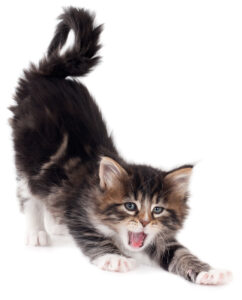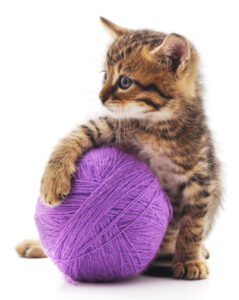Ten out of ten kittens prefer a vet who doesn’t declaw.

Help The Paw Project and be a part of movie-making history for a new documentary made about and by cats. How? Your tax-deductible contributions to The Paw Project will help promote “American Cats: The Good, The Bad, and The Cuddly,” a film that exposes the scandal of cat declawing in the United States. Learn more about this Clawson & Clawson Cinematics production ».
The Paw Project is a 501(c)(3) non-profit organization with one goal: end the cruel and unnecessary practice of feline declawing. For more than two decades, we have been committed to educating the public, legislators and veterinarians about how this potentially crippling surgical procedure can harm a cat’s physical health and result in disturbing behavioral changes. Unsuspecting cat guardians are often unaware that declawing is an amputation of a cat’s toes at the last joint. They do not realize that negative behavioral and health changes caused by declawing can be irreversible and permanent, in effect, trading one set of problems for another.
The Paw Project is dedicated to correcting misinformation and debunking myths about declawing which aim to reassure pet owners that declawing their cat isn’t all that bad or may even be beneficial. Make no mistake – cats do not benefit from declaw surgery. In fact, declawing can result in unintended, sometimes disastrous, consequences for cats.
There are humane alternatives to declawing that promote the safety and health of your cat as well as you, your family and all your other pets. Learn to understand how cats use their claws and how safe alternatives can spare your cat from having its toes amputated.
Looking for a paw-friendly vet who won’t declaw? Click on the interactive map below to find a veterinarian in your U.S. state or Canadian province.
Help us help cats, and join us in getting out this message: Cat Paws Need Their Claws.
Find A Paw Friendly Vet
Who Won’t Declaw
Many veterinarians refuse to perform declaw surgery, because they believe amputating a cat’s toes is unethical and provides no benefit whatsoever to the cat. In fact, it can result in permanent, adverse changes to its health and temperament.
Hundreds of veterinary clinics throughout the United States and Canada are listed in our directory of “No-Declaw” veterinarians. Click on the adjacent interactive map to find a no-declaw clinic in your state or province. For more general information, visit our No-Declaw Vets page.
What Is Declawing?
Declawing, also called de-knuckling, partial digital amputation, or onychectomy, is a surgical procedure in which the animal’s toes are amputated at the last joint. The term “declawing” is deceptive and inaccurate because the procedure is much more than merely removing the claw. Most people do not realize that a portion of the bone, from which the claw grows, must be removed in order to remove the nail. Declaw surgery is usually performed when the animal is young. Some felines will suffer immediate complications from the procedure, but for others the damaging effects of declawing may not become obvious until many months or years later. Permanent lameness, arthritis and other long-term complications are associated with declawing.
Declawing isn’t beneficial for you, your family or your cat

Imagine how you would feel or how well you would function without your fingers and toes. Feline declawing is a major surgical procedure in which a cat’s toes are amputated at the last bone. It is not a minor operation comparable to removing an ingrown toenail in a human – uncomfortable, perhaps mildly painful, but hardly traumatic or permanently debilitating. Unlike human nails, which grow from skin cells, a cat’s claws grow directly from the bone. When a cat is declawed, bones, tendons and nerves are severed.
Imagine walking with a pebble in your shoe every minute of every day of your life. Nail regrowth or residual bone fragments left behind from declaw surgery can result in a lifetime of excruciating pain for cats simply trying to stand or walk on their tender paw pads. Declawed cats may develop health problems such as infection, arthritis or lameness. Deprived of acting on their natural instinct to use their claws to climb, exercise and mark territory with the scent glands in their paws, they may undergo disturbing personality and behavioral changes which lead to being abandoned or relinquished to a shelter.
If you’re thinking about the best way to protect your kids, your other pets and your furniture, there are better alternatives for your cat than potentially crippling declaw surgery. Read on and we’ll show you how you can keep your cats healthy and happy, with their toes intact.
A Closer Look:
How Declawing Hurts Your Cat
Cats normally walk with their toes bearing the weight of their bodies, with each step cushioned by the pad under the toe. Declawed cats experience extreme pain supporting their body weight, if the tendon attached to the retained segment of the third toe bone pulls it backward under the foot. Also, bone fragments may contain remnants of nail-forming tissue that may continue to grow deep within the foot, causing inflammatory infection. Displaced bone fragments produce a painful “pebble-in-the-shoe” sensation when the animal stands or tries to walk.
Whether the cause is residual bone fragments, nail regrowth, inflammation or infection, felines may compensate for pain in their tender paws by shifting their weight farther back on their feet, in effect walking on their “wrists.” In more severe cases, the animal may walk on its “elbows.” The stresses caused by the abnormal posture and movement may produce arthritis in the legs, which, in turn, may cripple the cat further and cause it more suffering.
Alternatives to declawing:
Your furniture, family and other pets
When a cat experiences pain or anxiety, it often isn’t obvious to humans. Changes in personality can be an indication that your cat is in distress. Undesirable new behaviors are another way your cat may show you that it’s suffering. Deprived of their natural defenses, cats are acutely aware of their vulnerability without their claws, so they may become irritable and lash out, biting to protect themselves. They may avoid the litter box, because it hurts their paws to dig in the sand. These and other unwanted behaviors can cause more damage to your furniture, family and other pets than might otherwise occur with their claws left intact. The result is strife in the household, a lot of stress for the cat and higher vet bills.
Protect your cats’ health and happiness
by understanding how and why
they use their claws.
Avoid scratching of your:
Alternatives to declawing:
Your furniture

Scratching is a natural behavior, it’s not malicious. Cats instinctively mark their territory with the scent glands in their paws as a way to say they own you and the home they share with you. Declawed cats cannot use their paws to mark their territory in the manner that nature intended, so they may resort to marking furniture and carpets with urine, instead.
Provide a suitable outlet for your cat’s natural instinct to stretch and exercise its claws by placing a scratching post near where it might like to scratch. Place scratching posts around your home (they come in all shapes and styles to match your decor), and let your cat choose the ones it likes. You can also try nail caps. They’re simple and slip right over the claws.
The Paw Project
Alternatives to declawing:
Your family
An unintended consequence of declawing is that it often results in one unwanted behavior being replaced with a worse one that’s more difficult to manage. Claws are the primary defense cats use to protect themselves, so declawed cats will resort to other means of self-protection such as biting when they feel threatened or antagonized.

As your new cat gets used to unfamiliar surroundings, teach your family members, especially youngsters, how to interact in a way that doesn’t confuse or agitate the cat. Cats are most comfortable when they can come and go freely. They don’t always understand human intentions and may recoil from a child’s enthusiastic hug, mistaking it for aggression, which triggers their innate “flight or fight” response. Be aware that your own body language can seem intimidating. Sudden movements like grabbing at the cat and loud noises like shrieking or screaming will only frighten it. Move slowly, bend down and sit quietly to make the cat feel safe coming to you – on its own terms.
Like all animals, cats are very particular about how they are approached or handled. Some cats love it when you pet them but panic if you pick them up. Your cat may prefer petting with gentle short strokes of the hand. Long, heavy-handed strokes may overstimulate the cat. Learn to recognize the cues your cat signals when it has had too much stimulation – the ears go back, it might hiss or crouch down and pull away. When that happens, it’s time to leave it alone.
To foster bonding, schedule playtime when your cat can indulge its instinctual need to stalk prey. Favorite toys include feathered wands, lasers, or string – there is an endless variety of cat toys that you can buy or make yourself. Make time for play sessions every day that lasts at least 20 minutes. Encourage rather than discourage their natural instincts.
The Paw Project
Alternatives to declawing:
Your other animals

Declawed cats cannot protect themselves from perceived threats, so they’ll compensate by exhibiting aggressive behavior such as biting, attacking or urinating around the house to mark their territory. Declawing of outside cats renders them defenseless against predators and other territorial animals, including cats. The prospects of survival are poor for a declawed outdoor cat.
When bringing a new cat home, give it time to acclimate to its new surroundings and family members. Because felines are territorial, it’s best to keep your new cat in one room with food, water and a litter box until it becomes curious about what lies beyond the door. When it’s time to introduce all the animals, feed them on opposite sides of the door so they can sniff each other. Eventually, open the door but provide a gate or other barrier until everyone is comfortable. Slowly, let them get used to each other and become life-long friends.
The Paw Project
Cat paws need their claws.
Help us protect them.
Join us in bringing an end to feline declawing
Debunking myths about declawing.
Declawing, or onychectomy (än-ik-ek-tō-mē), is not minor surgery. It’s a major, potentially crippling procedure. It’s also known as de-knuckling for good reason – it is the amputation of the last bone in each of the ten front toes of a cat’s paws. An analogous procedure applied to humans would be cutting off the fingers and toes at the last joint.
Feline declawing also involves severing the tendons, nerves and ligaments. The results can be debilitating, impairing a cat’s normal functions such as being able to balance and walk on its toes. It also deprives a cat of normal movements such as being able to grasp with its paws.
Declawing will not diminish a cat’s natural territorial instincts. Whether you have an inside or an outside cat, it needs to feel secure about defending itself and its turf. Regardless of the environment – indoors or outdoors – all cats use their claws to climb, exercise and mark territory with the scent glands in their paws. If they cannot rely on these natural attributes, they may compensate by developing new behaviors, such as urinating on the furniture to mark their territory. The risks for outdoor cats can be dire. When deprived of its primary means of defense, a cat is more susceptible to injury or death, if attacked by other animals.
Declawing will not make a cat more docile. If anything, it is likely to result in one undesirable behavior being replaced by a worse one that’s harder to control. No longer able to defend themselves without their claws, some cats undergo personality changes. They may become aggressive and lash out, some become biters. Chronic pain and other health issues may also produce behavioral changes. For example, litter box avoidance is a common response when digging inflames a cat’s tender paws.
Declawing is not a no- or low-risk procedure. Bad health outcomes long-term are not uncommon. Nail regrowth through the paw pads or residual sharp bone fragments being left behind under the paw pads are risks associated with declaw surgery. Lameness, arthritis, stiff joints, inflammation from infection and chronic pain in cats are bad health outcomes associated with declawing. Changes in temperament or behavior may be associated with feeling just plain miserable. For example, a cat may avoid the litter box, not because it wants to punish the owner, but because it hurts to dig in the coarse sand.
Declawing will not ensure that a cat finds a forever home. There are no data to substantiate the claim that declawing protects cats from being abandoned or relinquished to a shelter. Regardless of the reason – whether the cat undergoes personality or behavioral changes or it experiences health problems after having been declawed – cat owners are often unprepared or unwilling to deal with the attendant headaches and expenses of caring for a declawed cat.
… So why would a vet
offer to perform a surgical procedure
that has no health benefit for your cat?
Vets offer declawing because they don’t want to lose you as a client if they refuse to perform the procedure. Now that you know why you shouldn’t declaw, let your vet know that you would prefer a vet who also doesn’t declaw.
Latest News.




















